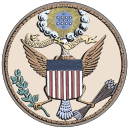
Back Maryland durant la guerre de Sécession French Maryland nella guerra di secessione americana Italian
 |
|
Union states in the American Civil War |
|---|
|
|
| Dual governments |
| Territories and D.C. |

During the American Civil War (1861–1865), Maryland, a slave state, was one of the border states, straddling the South and North. Despite some popular support for the cause of the Confederate States of America, Maryland did not secede during the Civil War. Governor Thomas H. Hicks, despite his early sympathies for the South, helped prevent the state from seceding.
Because the state bordered the District of Columbia and the opposing factions within the state strongly desired to sway public opinion towards their respective causes, Maryland played an important role in the war. The Presidency of Abraham Lincoln (1861–1865) suspended the constitutional right of habeas corpus from Washington to Philadelphia. Lincoln ignored the ruling of Chief Justice Roger B. Taney in "Ex parte Merryman" decision in 1861 concerning freeing John Merryman, a prominent Southern sympathizer arrested by the military.
The first fatalities of the war happened during the Baltimore riot of 1861 on April 18–19. The single bloodiest day of combat in American military history occurred during the first major Confederate invasion of the North in the Maryland Campaign, just north above the Potomac River near Sharpsburg in Washington County, at the Battle of Antietam on September 17, 1862. The battle of Antietam, though tactically a draw, was strategically enough of a Union victory to give Lincoln the opportunity to issue, in September 1862, the Emancipation Proclamation. It did not affect Maryland. In July 1864 the Battle of Monocacy was fought near Frederick, Maryland as part of the Valley Campaigns of 1864. Monocacy was a tactical victory for the Confederate States Army but a strategic defeat, as the one-day delay inflicted on the attacking Confederates cost rebel General Jubal Early his chance to capture the Union capital of Washington, D.C.
Across the state, some 50,000 citizens signed up for the military, with most joining the United States Army. Approximately a tenth as many enlisted to "go South" and fight for the Confederacy. Abolition of slavery in Maryland came before the end of the war, with a new third constitution voted approval in 1864 by a small majority of Radical Republican Unionists then controlling the nominally Democratic state.